George Frederick Dickson
born 2. May 1787 in Manchester, England
died 14. February 1859 in London, England
died 14. February 1859 in London, England
>> next >>
>> next >>
>> next >>
>> next >>
<< back <<
<< back <<
<< back <<
<< back <<
G.F.Dickson the Diplomat and Politician 1839 - 1859

© Kurt Müller 2012




Homepage auf
Deutsch
Deutsch




Homepage auf
Deutsch
Deutsch




Homepage auf
Deutsch
Deutsch


Homepage in
English
English



Homepage in
English
English




Homepage in
English
English
Homepage
George Dickson (I)
George Dickson (I)

Homepage
George Dickson (I)
George Dickson (I)

>> next >>
>> next >>
>> next >>
>> next >>
<< back <<
<< back <<
<< back <<
<< back <<
* We owe great gratitude to our cousin Michael Dickson who made this and other treasures accessible and consented to their publication here.

On the 14th February 1859 G.F.Dickson, died, 71 years old, in his house 20 Hanover Terrace, Regent's Park, London, still the Argentinian consul, and also the Argentine public took notice of his death (see left).
His sons Spencer Naylor und Frederick Cartwright continued his diplomatic work.

From
1837 *
(or earlier) George Frederick Dickson was "
Consul- general for the Republic of the United States of Rio de la Plata
", the future Argentine.
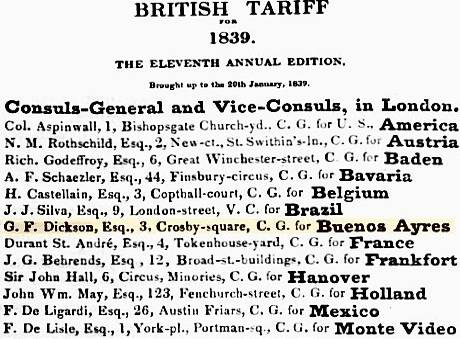
Excerpt from:
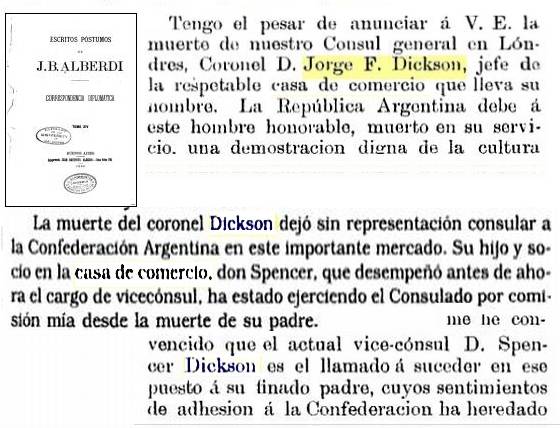

When civil war in the River Plate area and conflicts with Brazil and Uruguay, having flared up again with the sea blockade of Buenos Aires, were still in progress, G.F.Dickson was struck by a tragic fatality: his second youngest son George William, who was travelling for leisure and his education, became the victim of an assassination and died at the age of just 23 years in Montevideo, Uruguay.
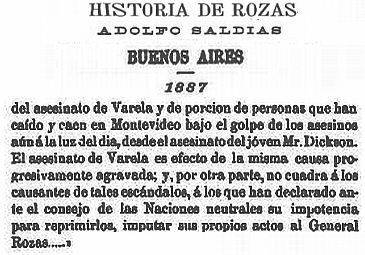

G.F.Dickson in Buenos Aires
G.F.Dickson in Buenos Aires
G.F.Dickson in Buenos Aires
G.F.Dickson in Buenos Aires
G.F.Dickson of Abbots Reading
G.F.Dickson of Abbots Reading
G.F.Dickson of Abbots Reading
G.F.Dickson of Abbots Reading
G.F.Dickson in Liverpool
G.F.Dickson in Liverpool
G.F.Dickson in Liverpool
G.F.Dickson in Liverpool
G.F.Dickson the Botanist
G.F.Dickson the Botanist
G.F.Dickson the Botanist
G.F.Dickson the Botanist
G.F.Dickson in London
G.F.Dickson in London
G.F.Dickson in London
G.F.Dickson in London




Diese Seite auf
Deutsch
Deutsch



This page in German





Diese Seite auf
Deutsch
Deutsch




Diese Seite auf
Deutsch
Deutsch




Diese Seite auf
Deutsch
Deutsch
Family history Müller - Humphreys
Above:G.F.Dickson at the height of his success *

In 1852 De Rosas was expelled by Urquiza and united Argentinian and Brazilian forces. Then a democratic constitution was passed which was the basis for Buenos Aires and the other states of the Argentinian confederation to unite again. The Argentinian Republic was brought into being (at first, though, without the city of Buenos Aires). In its first year,
G.F.Dickson served as an Argentinian minister (1853)
.
From his time as a consul and minister a number of documents exist, for instance regarding the - apparently old - controversy about the "Islas Malvinas", the Falkland Islands.

For most of this time (until 1852) the state represented by G.F.Dickson was ruled by Juan Manuel de Rosas who started as an elected governor and "Restaurador de las Leyes" but soon assumed dictatorial powers and behaviour. This "Exterminador de la Anarquia" and "Caudillo" -as he was called - "ruled ... with an iron fist and kept the fragile Confederation under the tutelage of Buenos Aires Province" (Wikipedia). De Rosas was married to one of the first female politicians of Argentine, Maria Encarnación Josepha de Ezcurra y Arguibel (1795 - 1838, right) who seems to have emanated a similar nimbus to that of a later dictator's wife, Eva Peron, and to be part of this specific Argentine tradition.
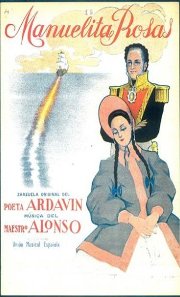

Poster advertising
the Zarzuela "Manuelita Rosas"
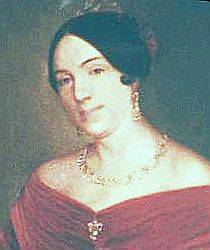

Manuelita de Rosas

Jorge Federico Dickson, prominente comerciante ingles
, conocedor de la inteligencia del Libertador, le dirige una carta requiriendo su opinión sobre la intervención. San martín, sin pérdida de tiempo le responde el 28 de diciembre de 1845 con un brillante análisis:
“Señor de todo mi aprecio: se me ha hecho saber los deseos de Ud. relativos a conocer mi opinión sobre la actual intervención de Ingla-terra y Francia en la República Argentina; no solo me presto gustoso a satisfacerlo sino o lo haré con la franqueza de mi carácter y la más absoluta imparcialidad.No creo oportuno entrar a investigar la justicia o la injusticia de la citada intervención, como los perjuicios que de ello resultarán a los súbditos de ambas naciones con la paralización de las relaciones comerciales, igualmente de la alarma y desconfianza que habrá producido en los Estados Sudamericanos (obsérvese la sagacidad de San Martín al decir que no se pone a investigar pero ya está adelantando algunos resultados que acarreará la intervención europea)..., solo me ceñiré a demostrar si las dos naciones interventoras conseguirán por lo medios coercitivos que han empleado el objeto que se han propuesto, es decir , la pacificación de las riberas del Plata.”
(Otero Pacífico, cit.por Jorge Sulé en “a coherencia política de San Martin.p.61)
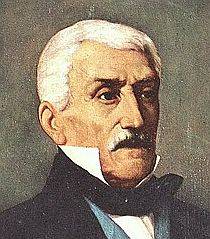

San Martín

During G.F.Dickson's time as a consul the young independent state twice had to cope with the sea blockade of Great Powers, in summary for 8 years kept by France and - within this time - for 4 years by Britain. So especially these years were times when G.F.Dickson - as a British citizen after all - was in a difficult position and had to fulfill strong diplomatic demands. So in the first year of the British blockade (1845) he asked a "retired" legendary fighter for South american independence (from spanish rule), José de San Martín, called "El Libertador", for his opinion. San Martín's answer was published in Europe on the 12th of February 1846 in the London paper "Morning Chronicle", caused great stir and was quoted many times

After Encarnación's early death her daughter Manuela Robustiana Ortiz de Rozas y Ezcurra took over her duties and her nimbus, exceeding her eventually in this respect. In 1941 - still before "Evita" Perón's time - "Manuelita" became the heroine of a successful "Zarzuela" (operette) by Francisco Alonso (see above). And together with her father who seems to be rehabilitated today she adorns the present-day banknote of 20 Argentinian Pesos (below).
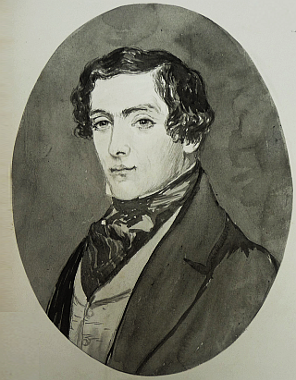

George William
Dickson


After his fall, De Rosas took exile in Britain, accompanied by his daughter Manuelita and followed by her husband Maximo Terrrero. They stayed there for the rest of their lives. De Rosas (born 1793) became a farmer in Swaythling, Sussex (right: De Rosas' cottage), and lived there for 25 more years. He died in 1877. His daughter (born 1817) gave birth to two children in England. She died there in 1898.
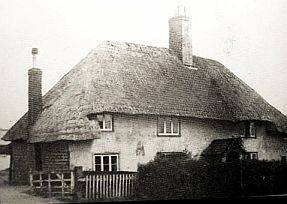
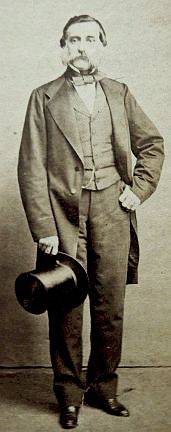

Manuelita's husband Maximo Terrero
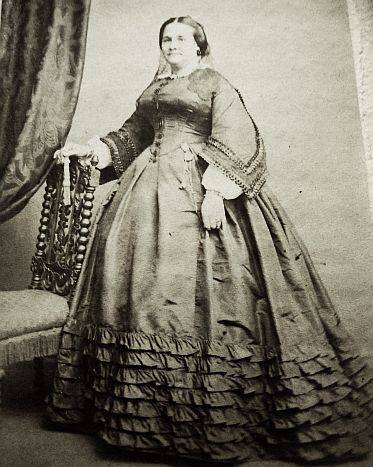

Manuelita Terrero - de Rosas
in England
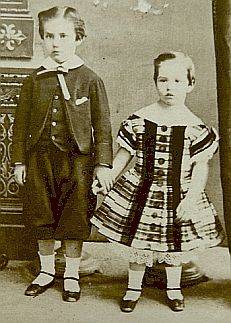

The Terreros'
children

These three pictures (left, right) showing the family of Manuelita Terrero come from the family photo album of G.F.Dickson's daughter -in-law Harriett Dickson. It is not clear, though, whether this means that there was personal contact between the Terrero and the dickson family or whether these pictures were chosen because of the meaning which the De Rosas family once had had for Argentine and thus for the Dicksons.
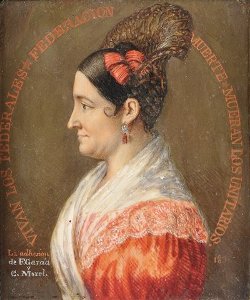

Encarnación de Ezcurra
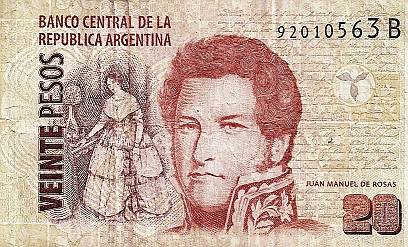

Governor
De Rosas
Manuelita de Rosas
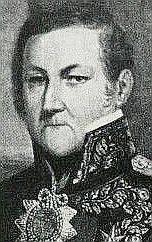

De Rosas
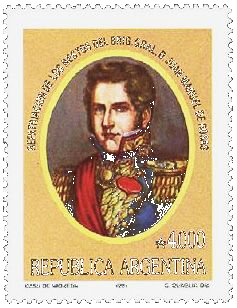

It is not quite clear, whether this assassination was targeted at him personally - as Argentinian sources insinuate, interpreting this event as the start of the increasing assassination activities in Montevideo in those days (see it being mentioned in the "Historia de Rozas", right below) -or whether he just accidentally was hit by a shot intended for someone else - as the family records say (see the description by the sister-in-law of the victim, Harriett Dickson, née Barker, below).

Further documents, regarding private as well as professional topics are kept in the "Plymouth and West Devon Record Office" in Plymouth, England, among the files of G.F.Dickson's sollicitors "Bewes, Dickinson and Scott, Solicitors of Plymouth". Also in the Guildhall Library in London a number of documents are kept regarding G.F.Dickson's acitivities.

So apparently these new dimensions of his activities came with his move to London during 1835, at first to Clarence Terrace, Regent's Park, a year later to 20, Hanover Terrace, Regent's Park (other addresses of the consulate were: 3 Crosby Square, 27 New Broad Street and 1
_
Winchester Buildings, Old Broad Street). This public role was ended only by his death even if in his last years more and more duties (including new functions and offices) were transferred to his sons. [*
then mentioned as one of the subscribers of the "THE YEARLY JOURNAL OF TRADE, 1837-8"]
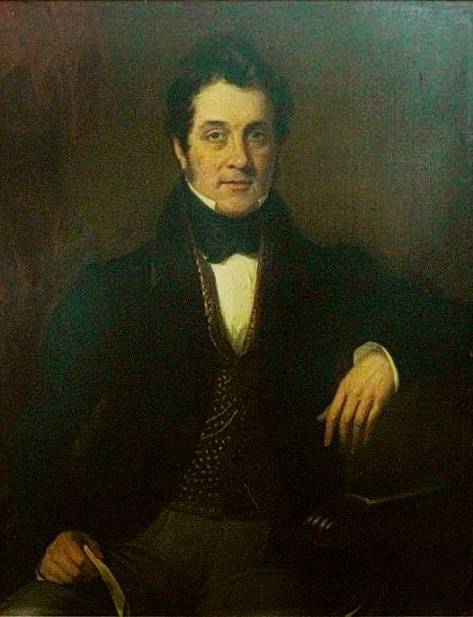
X
X
X
X
Black Beck
Black Beck
Black Beck
Black Beck
Underfield
Underfield
Underfield
Underfield
Abbots Reading
Abbots Reading
Abbots Reading
Abbots Reading
Personal pages
George Frederick Dickson
Personal pages
George Frederick Dickson
Personal pages
George Frederick Dickson
Personal pages
George Frederick Dickson
G.F.Dickson Buenos Aires
G.F.Dickson Buenos Aires
G.F.Dickson Buenos
G.F.Dickson Buenos Aires
G.F.Dickson Everton
G.F.Dickson Everton
G.F.Dickson Everton
G.F.Dickson Everton
G.F.Dickson Botanist
G.F.Dickson Botanist
G.F.Dickson Botanist
G.F.Dickson Botanist
G.F.Dickson London
G.F.Dickson London
G.F.Dickson London
G.F.Dickson London
G.F.Dickson Cumbria
G.F.Dickson Cumbria
G.F.Dickson Cumbria
G.F.Dickson Cumbria
G.F.Dickson Diplomat
G.F.Dickson Diplomat
G.F.Dickson Diplomat
G.F.Dickson Diplomat
Personal page
Jane Jones
Jane Jones
Personal page
Jane Jones
Jane Jones
Personal page
Jane Jones
Jane Jones
Personal page
Jane Jones
Jane Jones
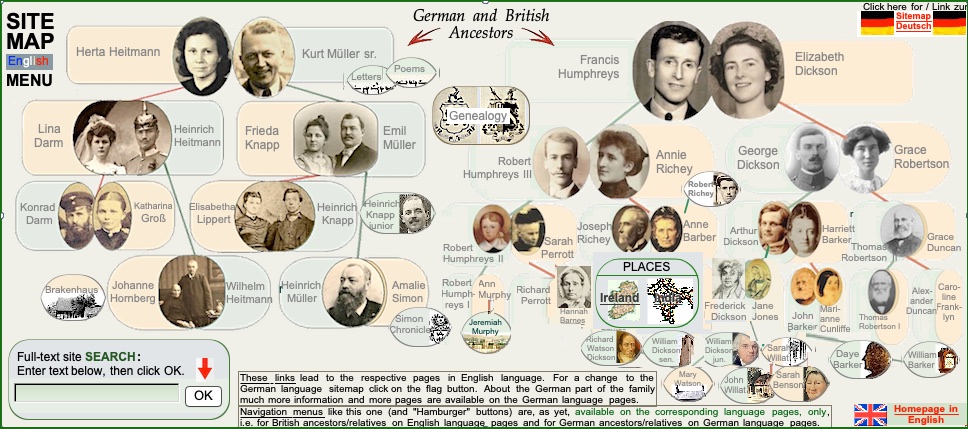
English
MENU


German and British
Ancestors


r

r

r

/

/
/

Genealogie

Genealogie

Genealogie

These links lead to the respective pages in English language. For a change to the German language sitemap click on the flag button. About the German part of the family much more information and more pages are available on the German language pages.

Navigation menus like this one (and "Hamburger" buttons) are, as yet, available on the corresponding language pages, only, i.e. for British ancestors/relatives on English language pages and for German ancestors/relatives on German language pages.
Click here for / Link zur




Homepage in
English
English




Homepage in
English
English




Homepage in
English
English




Homepage in
English
English




















Sitemap in
English
English


Sitemap in
English
English


Sitemap in
English
English


Sitemap in
English
English


Click here for / Link zur




Homepage auf
Deutsch
Deutsch




Homepage auf
Deutsch
Deutsch




Homepage auf
Deutsch
Deutsch




Homepage auf
Deutsch
Deutsch
deutsch
MENÜ
Click here for / Link zur

zurück zum
Navigationsmenü
zurück zum
Navigationsmenü
zurück zum
Navigationsmenü
zurück zum
Navigationsmenü
ORTE




Vorfahren
Deutsche und Britische
Diese Links führen zu den jeweiligen Seiten in deutscher Sprache. Um zur englischen Sitemap zu gelangen, bitte den UK/US-Flaggenbutton anklicken. Über den britischen Zweig der Familie sind erheblich mehr Informationen und mehr Seiten in englischer Sprache vorhanden als in deutscher und umgekehrt.


Ferdinand Simon USA


Ferdinand Simon USA


Ferdinand Simon USA

Ludweiler
Otterberg
Otterberg

Familie
Darm
Darm

Ludweiler
Otterberg
Otterberg

Familie
Darm
Darm

Ludweiler
Otterberg
Otterberg

Familie
Darm
Darm


/

/
/
Genealogy
Genealogy
Genealogy
Click here for / Link zur




Homepage in
English
English




Homepage in
English
English




Homepage in
English
English




Homepage in
English
English


Sitemap
Deutsch
Deutsch


Sitemap
Deutsch
Deutsch


Sitemap
Deutsch
Deutsch


Sitemap
Deutsch
Deutsch


Click here
to go back to the
site map menu
Click here
to go back to the
site map menu
Click here
to go back to the
site map menu
Click here
to go back to the
site map menu

r
r
r


Click here for / Link zur

back to
site map menu
back to
site map menu
back to
site map menu
back to
site map menu













These links lead to the respective pages in English language. For a change to the German language sitemap click on the German flag button. About the German part of the family, much more information and more pages are available on the German language pages. Navigation menus like this one are, as yet, available on the corresponding language pages, only, i.e. for British kin on English language pages, and for German kin on German language pages.

Ferdinand Simon USA

Ferdinand Simon USA

Ferdinand Simon USA

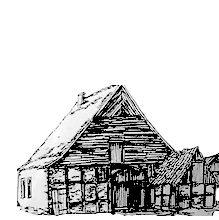




r

The Darm
Family
Family

Ludweiler
Otterberg
Otterberg
r

The Darm
Family
Family

Ludweiler
Otterberg
Otterberg
r

The Darm
Family
Family

Ludweiler
Otterberg
Otterberg


Menu

Menu

Menu

Menu